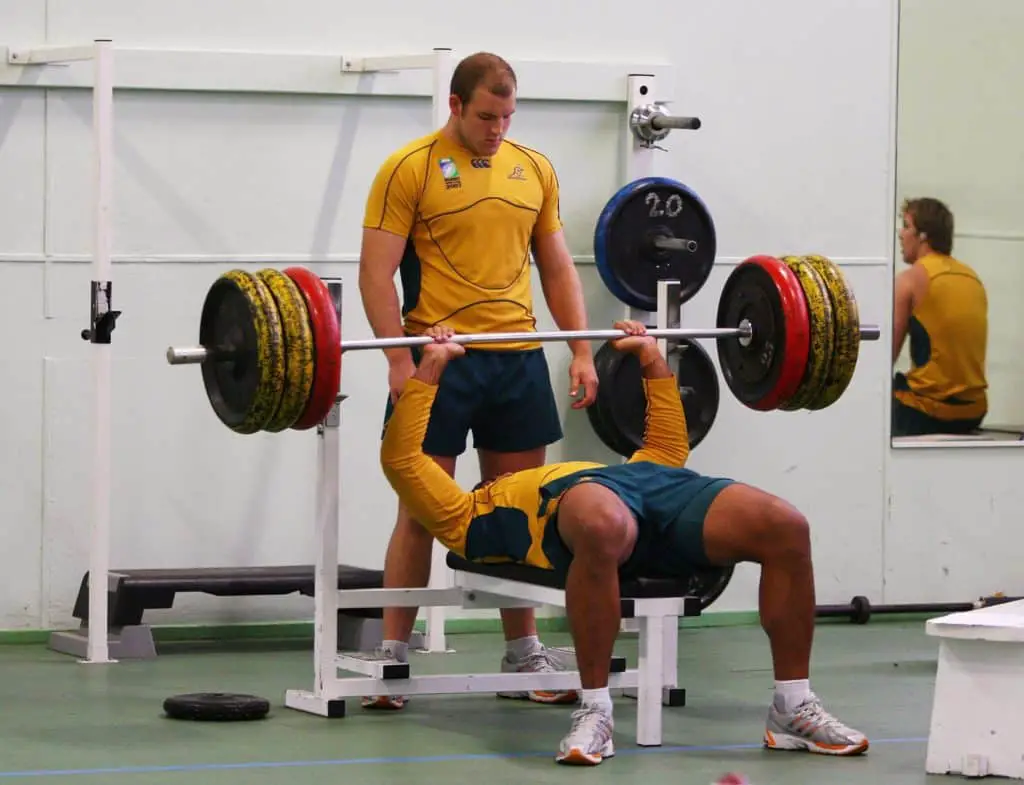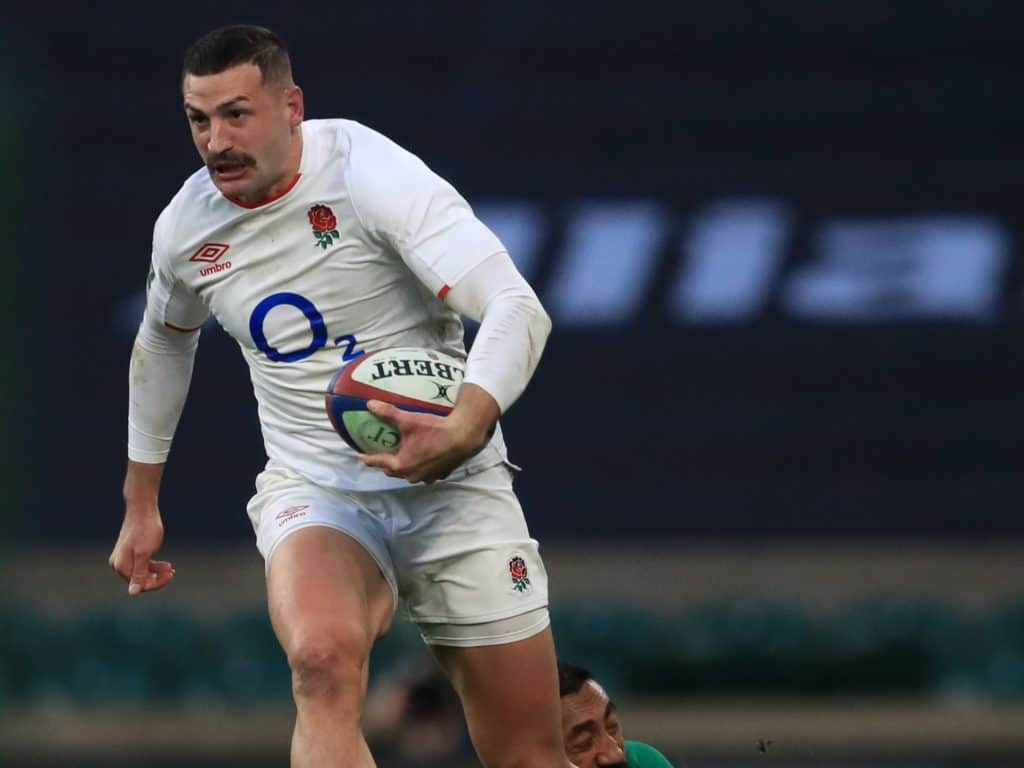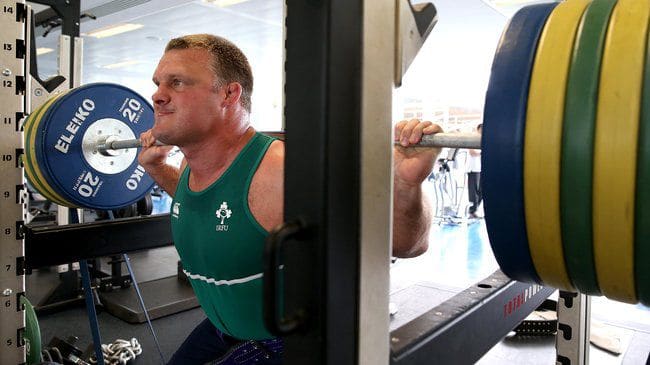
Rugby players need to be big, muscular and strong. That extra size and strength helps them bring other giant players crashing to the ground and gives them the ability to burst through tackles and go on barnstorming runs. We all know why rugby players need to be powerful but how exactly do they build this size?
Is powerlifting good for rugby?
Powerlifting is good for rugby. Powerlifting is an effective way for rugby players to increase their muscle mass and strength. Powerlifting will help rugby players become faster when running with the ball and generate more power when tackling and cleaning out.
Does Powerlifting Increase Rugby Players Muscle Mass?
Powerlifting is one of the most effective ways for rugby players to increase muscle mass. Studies have shown that using weights in the 80% to 90% during compound movements (squat, bench, deadlift) and performing 3 sets to failure is the quickest way to induce maximal muscle hypertrophy.

Burd, et al. found that protein synthesis was similar whether an athlete trained to failure with 90% or 30% sub maximal loads.
Mitchell, et al. studied 18 recreational athletes and had them perform a 10 week strength programing. One group performed 3 sets of 30% of their max until failure while the other group used 80% of their max.
The effect on muscle mass was found to be the same amongst both groups.
Now you may be thinking that based on these studies that rugby players should use lighter weights due to the same effect they had on muscle mass as heavier weights. However, the athletes who used heavier weights were able to complete their workouts much quicker than the other groups as they spent 15 seconds under tensions while the 30% group sent 45 seconds under tension.
As rugby players need to divide their time between all different types of training they are looking for strength workouts that can give them the most bang for their buck in the quickest time possible so they can focus on their rugby specific training. This is why performing heavy powerlifting workouts is the most effective for rugby players looking to put on size and muscle.
Does Powerlifting Make Rugby Players Faster?
Powerlifting, particularly the squat does make rugby players faster. McBride et al. (2009) found that athletes who had squat maxes over 2.1 times bodyweight were significantly faster across 10m and 40m than athletes who had lower squat to bodyweight ratios.

McBride et al. (2009) studied the squat maxes and sprinting speeds of 17 elite high school male football athletes. The average height was 1.78m, weight 85.9kg, squat max 166.5kg, and squat to bodyweight ratio 1.94. The athletes squat records were compared to their sprint times over 5, 10, and 40 metres.
Statistically significant (p ≤ 0.05) correlations were found between squat bodyweight ratio and 40 yard sprint times (r = −0.605) and 10 yard sprint times (r = −0.544). Subjects with a squat bodyweight ratio above 2.10 had statistically significantly lower sprint times at 10 and 40 yards in comparison with those subjects with a squat bodyweight ratio ratio below 1.90.
Powerlifting is all about helping to improve your 1 rep max in the squat, bench press and deadlift. As evidenced by the study above there is a significant positive relationship between max squat and sprint speeds. By powerlifting you will greatly increase your squat max which should positively improve your sprint speeds, turning you into a speed demon on the rugby pitch.
Does Powerlifting Make Rugby Players Better Tacklers?
Powerlifting, particularly the squat does make rugby players stronger tacklers. A study by Speranza et al. (2016) showed that rugby athletes who improved their max squat the most also improved their tackling power the most. Improvements to bench press did not result in higher tackling power.

Speranza et al. (2016) tested the max bench press, squat and tackling power of Twenty-four professional rugby league players. The rugby athletes then performed an 8 weeks of strength regime as part of their preseason training before being retested.
The strength training resulted in large improvements to the players’ bench press and squat records. The improvement in squat performance correlated the strongest with tackling (r = 0.60; p < 0.01). The rugby players with the highest improvement in squat performance also recorded the highest improvement in tackling performance. Interestingly, improvements in bench press did not result in improved tackling performance.
If you want to become a better tackler then you should be heading to your nearest squat rack and putting your legs through some brutal powerlifting squat workouts.
Is Powerlifting Dangerous For Rugby Players?
Powerlifting is one of the safest strength training systems for rugby players. Powerlifting has an injury rate of 1 per 1000 hours and most injuries are minor strains while Olympic weightlifting has an injury rate of 3.3 per 1000 hours.

Even though the chance of injuring yourself during powerlifting is low especially compared to rugby there is still a risk of injury. The most common injuries in powerlifting are to the lumbopelvic region, shoulder and hip. The bench press is most responsible for shoulder injuries while the squat is the cause of most hip injuries.
Fortunately, most of the injuries suffered in powerlifting are minor. A survey of injured powerlifters found that over 60% of injured athletes still continued to train as the training did not significantly affect their ability to lift weights.
The most dangerous powerlifting movement for rugby players is the squat. The squat is responsible for 42% of injuries during powerlifting while the bench press is responsible for 27% and the deadlift is responsible for 31%.
Despite the injury risk in powerlifting it is still a much safer alternative than Olympic weightlifting which is popular among certain rugby strength coaches. Based on studies powerlifting is 3x to 4x safer than Olympic weightlifting as it has an injury rate of between 3.3 to 4 per 1000 hours.
Olympic weightlifting is very strenuous on athletes’ backs, shoulders and knees. Athletes regularly suffer from strained muscles, herniated discs and tendonitis.
As studies have shown that powerlifting is more effective than Olympic weightlifting in building muscle and almost as effective in building power, rugby athletes should opt for the safer alternative and stick to powerlifting.
Conclusion
Powerlifting is highly beneficial for rugby players. Rugby players need a combination of high muscle mass, speed and strength. Powerlifting can help rugby players improve in all of those facets.
Performing powerlifting movements with 80% of an athlete’s maximum has shown to be the most effective in building muscle while developing maximal squatting power has shown to increase a rugby player’s tackling power while also reducing sprint times.
You combine this with the fact that powerlifting is much safer than other methods such as Olympic powerlifting then it becomes a no brainer that all rugby players should be powerlifting.
